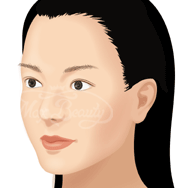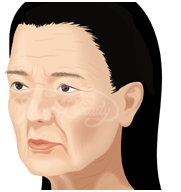Services

Services
♦Middle-age Aging Symptoms.jpg)
 |
 |
|
|
Having a perfect s-curve viewed from the side and full and distinctive features are the main features of youth. |
Reaching a certain age, the s-curve becomes an L-line, the marionette lines and nasolabial folds merge into one, and cheeks appear sunken, making the face look haggard without vigor. |
When you reach a certain age, you will discover that the “s line” from both sides of the face to the lower face gradually becomes deformed, from an “large S” to a “small S,” or even a straight line until the three-dimensional look disappears, the corners of the mouth droop, and the entire face becomes haggard without vigor.
♦Face Lift=Flat Face!?.jpg)
Endoscopic face lift has gradually become familiar to and accepted by the public, and middle face lift surgery has gradually gained popularity and attention. Problem such as symmetrical nasolabial lines on the lower lateral side of the face (Indiana lines, nasolabial folds, and marionette lines) as well as cheek sagging aging problems women in their early 30s are concerned about can be well improved. Endoscopic middle-face lift can improve and reproduce the 3D side face S curve and albinos muscle (risorius muscle) while changing the common “face lift=flat face” misconception.
.png) |
|
|
Tear ditch, nasolabial folds, marionette lines, and symmetrical nasolabial lines on the lower lateral side of the face. |
After cheek lift, the 38 pattern on the side is visibly improved. |
.png) |
|
| Drooping eyebrows, sagging cheeks without the 3D look. | Sagging after cheek lifting, concave tissues become full and three-dimensional. |
|
♦Fixation Materials When it comes to fixation materials, first-generation suture, second-generation metal screw nails, third generation resorbable bone screws, and the latest U.S. endotine forehead device fixation method are all currently performed by doctors. Surgical effectiveness often depends greatly on the fixation method and the quality of material used. First-generation, second-generation, and third-generation materials are more affordable, but the fixation time is insufficient, the postoperative results are often not lasting. On the other hand, the endotine fixation method completely overcomes problems of the first through the third generation of materials. In addition, it is safer and more stable. It is made from a material called polylactide containing lactic acid and acid polymer. Since multi-point fixation is adopted, the strain can be evenly distributed, making detachment less likely. Additionally, the endotine fixation nail will be absorbed and dissolved after six months to a year. No adverse effect has been reported so far, and it has been widely accepted in the international community with great popularity. It has also been many years since its introduction into Taiwan. This fixation method has replaced the traditional single-point fixation method. However, due to the higher cost, operation costs are relatively high.
♦Past Generations of Fixation Materials
♦Endoscopic Mid-Face Lift with Exquisite Procedure overcomes the setbacks of large wounds and scars with traditional lifting
|
.jpg)
